Legal Structures for IOM Solutions: A Business Law Analysis in UK
VerifiedAdded on 2023/06/14
|8
|2502
|410
Report
AI Summary
This report provides an analysis of various legal business structures available in the UK, including sole proprietorships, general partnerships, limited liability partnerships, and limited liability companies, within the context of the Companies Act 2006 and the Partnership Act of 1890. It discusses the advantages and disadvantages of each structure, focusing on factors such as liability, taxation, management, and capital formation. The report culminates in a recommendation for Sam, the owner of IOM Solutions, suggesting that a Limited Liability Company (LLC) would be the most suitable structure for his business expansion due to its ability to share responsibilities, retain higher profits, offer tax efficiency, attract investors, and provide limited personal liability. The report emphasizes the importance of proper business management and adherence to business law for effective functioning and long-term success, encouraging Sam to consider the LLC structure to balance his personal and professional life while facilitating business growth and profitability. Desklib provides a platform for students to access similar solved assignments and past papers for their studies.

Business Law
Paraphrase This Document
Need a fresh take? Get an instant paraphrase of this document with our AI Paraphraser
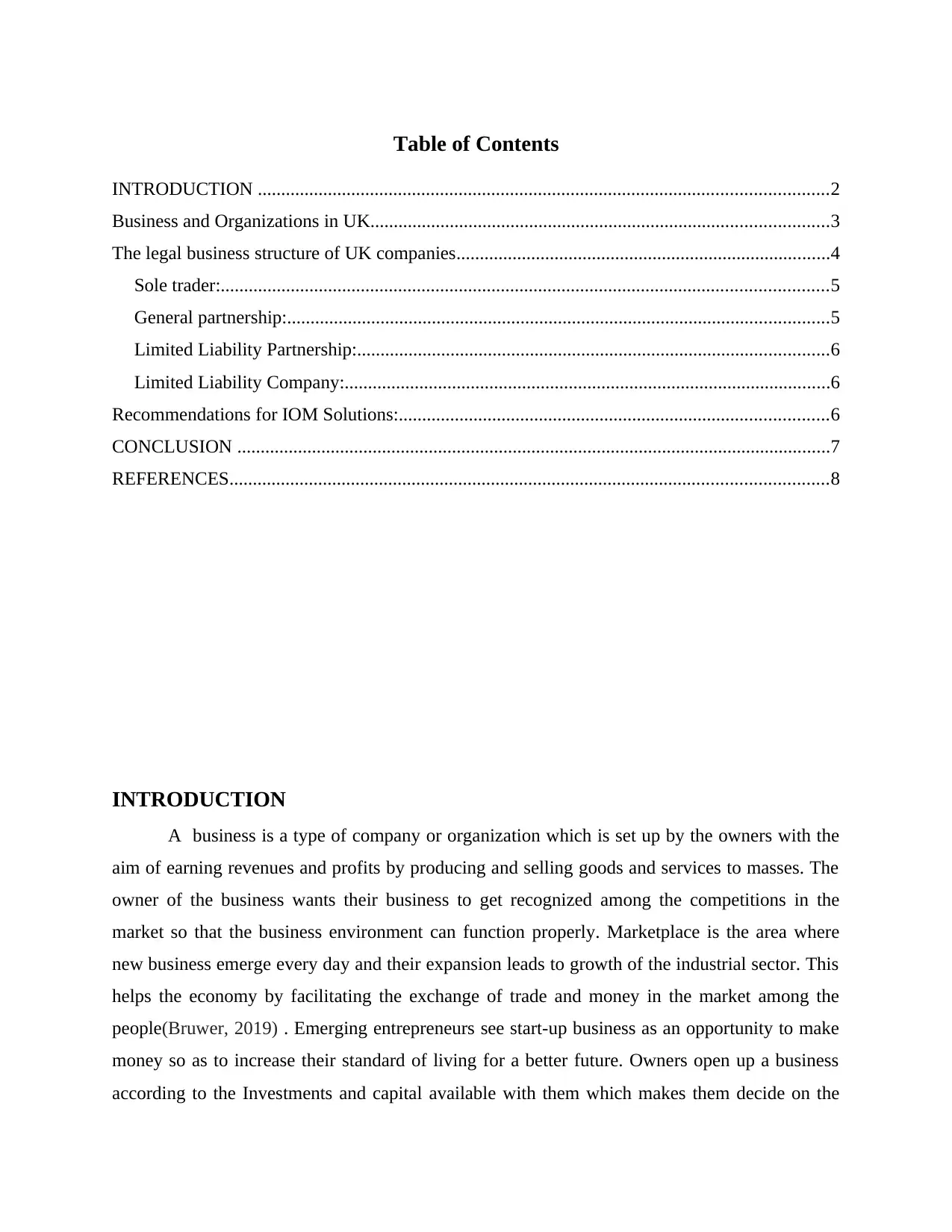
Table of Contents
INTRODUCTION ..........................................................................................................................2
Business and Organizations in UK..................................................................................................3
The legal business structure of UK companies................................................................................4
Sole trader:..................................................................................................................................5
General partnership:....................................................................................................................5
Limited Liability Partnership:.....................................................................................................6
Limited Liability Company:........................................................................................................6
Recommendations for IOM Solutions:............................................................................................6
CONCLUSION ...............................................................................................................................7
REFERENCES................................................................................................................................8
INTRODUCTION
A business is a type of company or organization which is set up by the owners with the
aim of earning revenues and profits by producing and selling goods and services to masses. The
owner of the business wants their business to get recognized among the competitions in the
market so that the business environment can function properly. Marketplace is the area where
new business emerge every day and their expansion leads to growth of the industrial sector. This
helps the economy by facilitating the exchange of trade and money in the market among the
people(Bruwer, 2019) . Emerging entrepreneurs see start-up business as an opportunity to make
money so as to increase their standard of living for a better future. Owners open up a business
according to the Investments and capital available with them which makes them decide on the
INTRODUCTION ..........................................................................................................................2
Business and Organizations in UK..................................................................................................3
The legal business structure of UK companies................................................................................4
Sole trader:..................................................................................................................................5
General partnership:....................................................................................................................5
Limited Liability Partnership:.....................................................................................................6
Limited Liability Company:........................................................................................................6
Recommendations for IOM Solutions:............................................................................................6
CONCLUSION ...............................................................................................................................7
REFERENCES................................................................................................................................8
INTRODUCTION
A business is a type of company or organization which is set up by the owners with the
aim of earning revenues and profits by producing and selling goods and services to masses. The
owner of the business wants their business to get recognized among the competitions in the
market so that the business environment can function properly. Marketplace is the area where
new business emerge every day and their expansion leads to growth of the industrial sector. This
helps the economy by facilitating the exchange of trade and money in the market among the
people(Bruwer, 2019) . Emerging entrepreneurs see start-up business as an opportunity to make
money so as to increase their standard of living for a better future. Owners open up a business
according to the Investments and capital available with them which makes them decide on the

type and size of business structure which they must choose like small, medium or large scale
business. Business law thus helps to understand the different legal business structures available
in UK. This project will provide information about the different business structures, their merits
and demerits and will give recommendation to Sam for a suitable type for his business expansion
of IOM Solutions.
Business and Organizations in UK
In UK, the business activities and its management are carried out according to the
Companies Act of 2006. It provides detailed provisions for the functioning of the business and
helps it to run effectively. A Business cannot run in the absence of its employees they are the
main assets of a company who help in carrying out the business operations smoothly. Thus their
behaviour and conduct should be according to the various employment legislations which
prescribe standards for their actions. But as for the companies they should abide by the
companies law to remain out of sight of any legal liabilities which arise due to non fulfilment of
obligations. The businesses while entering the market are given the identity of a professional
entity which then provides them with distinct legal identities that has various components within
it. Those components are perpetual existence, separate or distinct properties, a common stamp or
seal in the name of business and the rights and responsibilities of suing someone or getting sued
for non compliance of laws which gives rise to professional misconduct(Butturini, 2020). A
business at the time of its formation has various agreements that are concluded by its name so
that it can be started. These are under various heads and clauses which differentiate them from
each other like an agreement on sale and purchase of goods or letters of intent, etc.
Due to unprofessional behaviour of employees and the lack of the business in carrying
out its operations can give rise to various liabilities. One of such liabilities that arises in a
business is Vicarious liabilities that arises among the businesses who operate on a large scale.
These liabilities occur when an employee acts or behaves dishonestly or commits any wrongful
act while still being a part of an organization as its employee, then liability arises on the
employer because they are held liable and responsible for their employees actions and thus they
must act within time to avoid any problems. A business also suffers problems with respect to
negligent behaviour of any member or any employee while carrying out their roles and
responsibilities. Director is the person who is given the position of organizational head by which
they have various roles and duties that are assigned to their post which they need to perform with
business. Business law thus helps to understand the different legal business structures available
in UK. This project will provide information about the different business structures, their merits
and demerits and will give recommendation to Sam for a suitable type for his business expansion
of IOM Solutions.
Business and Organizations in UK
In UK, the business activities and its management are carried out according to the
Companies Act of 2006. It provides detailed provisions for the functioning of the business and
helps it to run effectively. A Business cannot run in the absence of its employees they are the
main assets of a company who help in carrying out the business operations smoothly. Thus their
behaviour and conduct should be according to the various employment legislations which
prescribe standards for their actions. But as for the companies they should abide by the
companies law to remain out of sight of any legal liabilities which arise due to non fulfilment of
obligations. The businesses while entering the market are given the identity of a professional
entity which then provides them with distinct legal identities that has various components within
it. Those components are perpetual existence, separate or distinct properties, a common stamp or
seal in the name of business and the rights and responsibilities of suing someone or getting sued
for non compliance of laws which gives rise to professional misconduct(Butturini, 2020). A
business at the time of its formation has various agreements that are concluded by its name so
that it can be started. These are under various heads and clauses which differentiate them from
each other like an agreement on sale and purchase of goods or letters of intent, etc.
Due to unprofessional behaviour of employees and the lack of the business in carrying
out its operations can give rise to various liabilities. One of such liabilities that arises in a
business is Vicarious liabilities that arises among the businesses who operate on a large scale.
These liabilities occur when an employee acts or behaves dishonestly or commits any wrongful
act while still being a part of an organization as its employee, then liability arises on the
employer because they are held liable and responsible for their employees actions and thus they
must act within time to avoid any problems. A business also suffers problems with respect to
negligent behaviour of any member or any employee while carrying out their roles and
responsibilities. Director is the person who is given the position of organizational head by which
they have various roles and duties that are assigned to their post which they need to perform with
⊘ This is a preview!⊘
Do you want full access?
Subscribe today to unlock all pages.

Trusted by 1+ million students worldwide
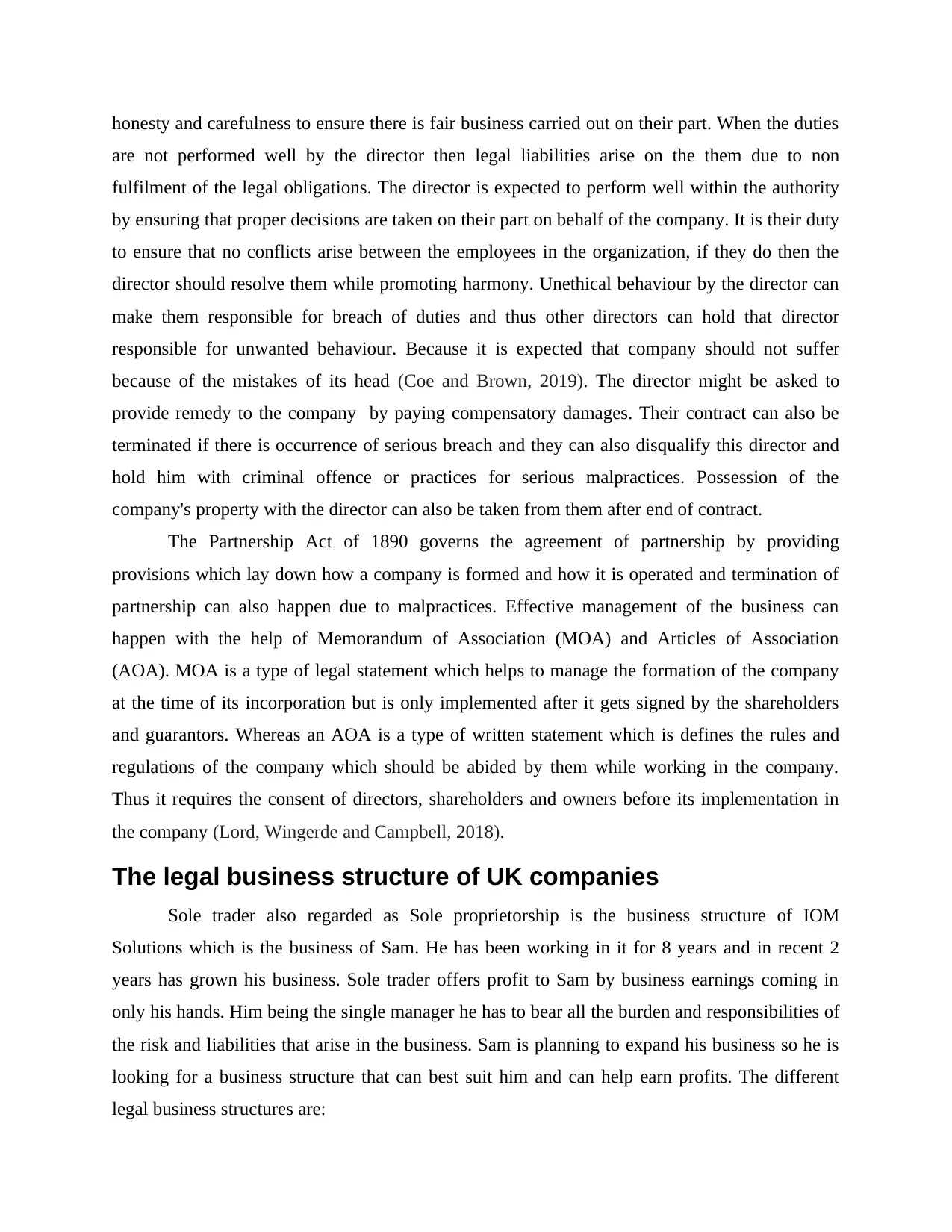
honesty and carefulness to ensure there is fair business carried out on their part. When the duties
are not performed well by the director then legal liabilities arise on the them due to non
fulfilment of the legal obligations. The director is expected to perform well within the authority
by ensuring that proper decisions are taken on their part on behalf of the company. It is their duty
to ensure that no conflicts arise between the employees in the organization, if they do then the
director should resolve them while promoting harmony. Unethical behaviour by the director can
make them responsible for breach of duties and thus other directors can hold that director
responsible for unwanted behaviour. Because it is expected that company should not suffer
because of the mistakes of its head (Coe and Brown, 2019). The director might be asked to
provide remedy to the company by paying compensatory damages. Their contract can also be
terminated if there is occurrence of serious breach and they can also disqualify this director and
hold him with criminal offence or practices for serious malpractices. Possession of the
company's property with the director can also be taken from them after end of contract.
The Partnership Act of 1890 governs the agreement of partnership by providing
provisions which lay down how a company is formed and how it is operated and termination of
partnership can also happen due to malpractices. Effective management of the business can
happen with the help of Memorandum of Association (MOA) and Articles of Association
(AOA). MOA is a type of legal statement which helps to manage the formation of the company
at the time of its incorporation but is only implemented after it gets signed by the shareholders
and guarantors. Whereas an AOA is a type of written statement which is defines the rules and
regulations of the company which should be abided by them while working in the company.
Thus it requires the consent of directors, shareholders and owners before its implementation in
the company (Lord, Wingerde and Campbell, 2018).
The legal business structure of UK companies
Sole trader also regarded as Sole proprietorship is the business structure of IOM
Solutions which is the business of Sam. He has been working in it for 8 years and in recent 2
years has grown his business. Sole trader offers profit to Sam by business earnings coming in
only his hands. Him being the single manager he has to bear all the burden and responsibilities of
the risk and liabilities that arise in the business. Sam is planning to expand his business so he is
looking for a business structure that can best suit him and can help earn profits. The different
legal business structures are:
are not performed well by the director then legal liabilities arise on the them due to non
fulfilment of the legal obligations. The director is expected to perform well within the authority
by ensuring that proper decisions are taken on their part on behalf of the company. It is their duty
to ensure that no conflicts arise between the employees in the organization, if they do then the
director should resolve them while promoting harmony. Unethical behaviour by the director can
make them responsible for breach of duties and thus other directors can hold that director
responsible for unwanted behaviour. Because it is expected that company should not suffer
because of the mistakes of its head (Coe and Brown, 2019). The director might be asked to
provide remedy to the company by paying compensatory damages. Their contract can also be
terminated if there is occurrence of serious breach and they can also disqualify this director and
hold him with criminal offence or practices for serious malpractices. Possession of the
company's property with the director can also be taken from them after end of contract.
The Partnership Act of 1890 governs the agreement of partnership by providing
provisions which lay down how a company is formed and how it is operated and termination of
partnership can also happen due to malpractices. Effective management of the business can
happen with the help of Memorandum of Association (MOA) and Articles of Association
(AOA). MOA is a type of legal statement which helps to manage the formation of the company
at the time of its incorporation but is only implemented after it gets signed by the shareholders
and guarantors. Whereas an AOA is a type of written statement which is defines the rules and
regulations of the company which should be abided by them while working in the company.
Thus it requires the consent of directors, shareholders and owners before its implementation in
the company (Lord, Wingerde and Campbell, 2018).
The legal business structure of UK companies
Sole trader also regarded as Sole proprietorship is the business structure of IOM
Solutions which is the business of Sam. He has been working in it for 8 years and in recent 2
years has grown his business. Sole trader offers profit to Sam by business earnings coming in
only his hands. Him being the single manager he has to bear all the burden and responsibilities of
the risk and liabilities that arise in the business. Sam is planning to expand his business so he is
looking for a business structure that can best suit him and can help earn profits. The different
legal business structures are:
Paraphrase This Document
Need a fresh take? Get an instant paraphrase of this document with our AI Paraphraser
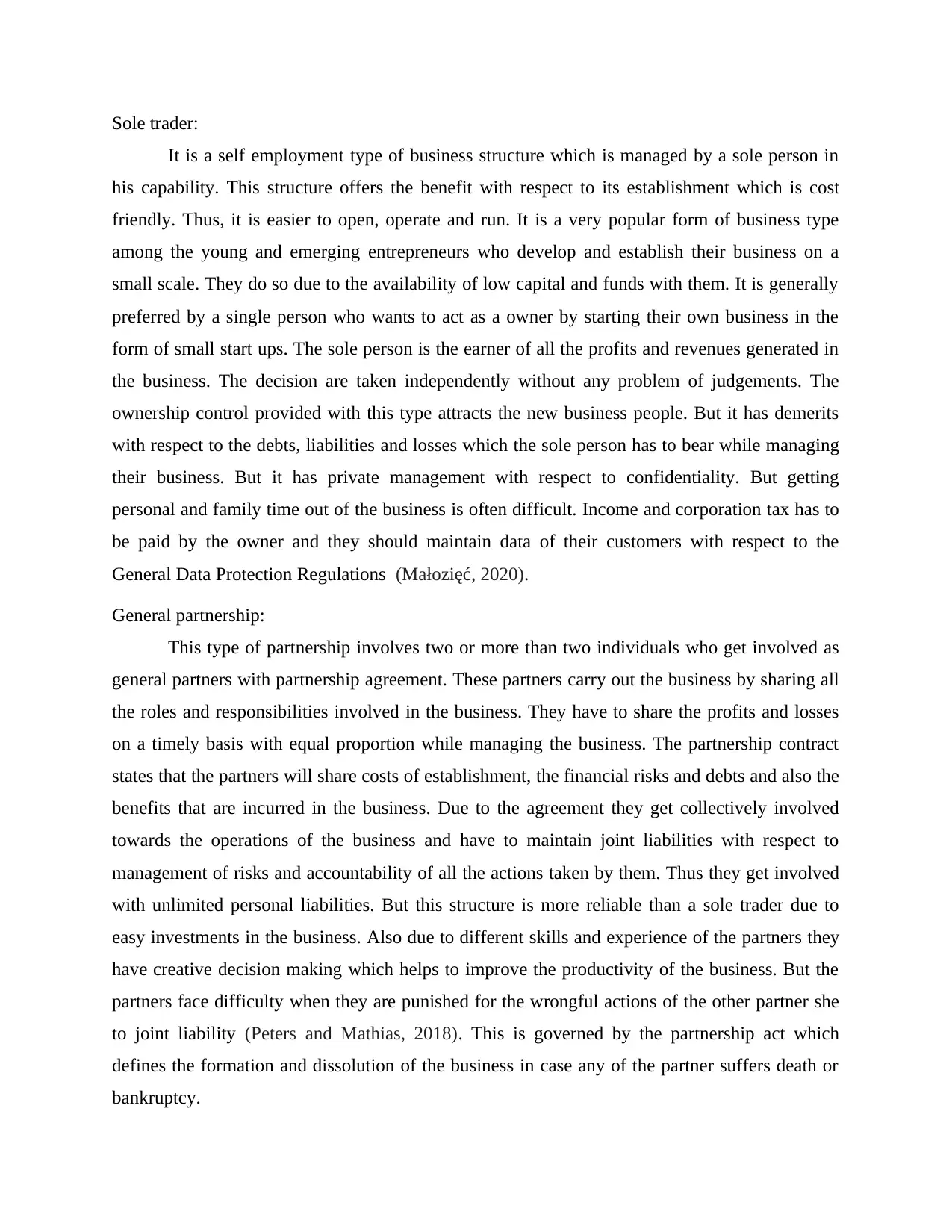
Sole trader:
It is a self employment type of business structure which is managed by a sole person in
his capability. This structure offers the benefit with respect to its establishment which is cost
friendly. Thus, it is easier to open, operate and run. It is a very popular form of business type
among the young and emerging entrepreneurs who develop and establish their business on a
small scale. They do so due to the availability of low capital and funds with them. It is generally
preferred by a single person who wants to act as a owner by starting their own business in the
form of small start ups. The sole person is the earner of all the profits and revenues generated in
the business. The decision are taken independently without any problem of judgements. The
ownership control provided with this type attracts the new business people. But it has demerits
with respect to the debts, liabilities and losses which the sole person has to bear while managing
their business. But it has private management with respect to confidentiality. But getting
personal and family time out of the business is often difficult. Income and corporation tax has to
be paid by the owner and they should maintain data of their customers with respect to the
General Data Protection Regulations (Małozięć, 2020).
General partnership:
This type of partnership involves two or more than two individuals who get involved as
general partners with partnership agreement. These partners carry out the business by sharing all
the roles and responsibilities involved in the business. They have to share the profits and losses
on a timely basis with equal proportion while managing the business. The partnership contract
states that the partners will share costs of establishment, the financial risks and debts and also the
benefits that are incurred in the business. Due to the agreement they get collectively involved
towards the operations of the business and have to maintain joint liabilities with respect to
management of risks and accountability of all the actions taken by them. Thus they get involved
with unlimited personal liabilities. But this structure is more reliable than a sole trader due to
easy investments in the business. Also due to different skills and experience of the partners they
have creative decision making which helps to improve the productivity of the business. But the
partners face difficulty when they are punished for the wrongful actions of the other partner she
to joint liability (Peters and Mathias, 2018). This is governed by the partnership act which
defines the formation and dissolution of the business in case any of the partner suffers death or
bankruptcy.
It is a self employment type of business structure which is managed by a sole person in
his capability. This structure offers the benefit with respect to its establishment which is cost
friendly. Thus, it is easier to open, operate and run. It is a very popular form of business type
among the young and emerging entrepreneurs who develop and establish their business on a
small scale. They do so due to the availability of low capital and funds with them. It is generally
preferred by a single person who wants to act as a owner by starting their own business in the
form of small start ups. The sole person is the earner of all the profits and revenues generated in
the business. The decision are taken independently without any problem of judgements. The
ownership control provided with this type attracts the new business people. But it has demerits
with respect to the debts, liabilities and losses which the sole person has to bear while managing
their business. But it has private management with respect to confidentiality. But getting
personal and family time out of the business is often difficult. Income and corporation tax has to
be paid by the owner and they should maintain data of their customers with respect to the
General Data Protection Regulations (Małozięć, 2020).
General partnership:
This type of partnership involves two or more than two individuals who get involved as
general partners with partnership agreement. These partners carry out the business by sharing all
the roles and responsibilities involved in the business. They have to share the profits and losses
on a timely basis with equal proportion while managing the business. The partnership contract
states that the partners will share costs of establishment, the financial risks and debts and also the
benefits that are incurred in the business. Due to the agreement they get collectively involved
towards the operations of the business and have to maintain joint liabilities with respect to
management of risks and accountability of all the actions taken by them. Thus they get involved
with unlimited personal liabilities. But this structure is more reliable than a sole trader due to
easy investments in the business. Also due to different skills and experience of the partners they
have creative decision making which helps to improve the productivity of the business. But the
partners face difficulty when they are punished for the wrongful actions of the other partner she
to joint liability (Peters and Mathias, 2018). This is governed by the partnership act which
defines the formation and dissolution of the business in case any of the partner suffers death or
bankruptcy.
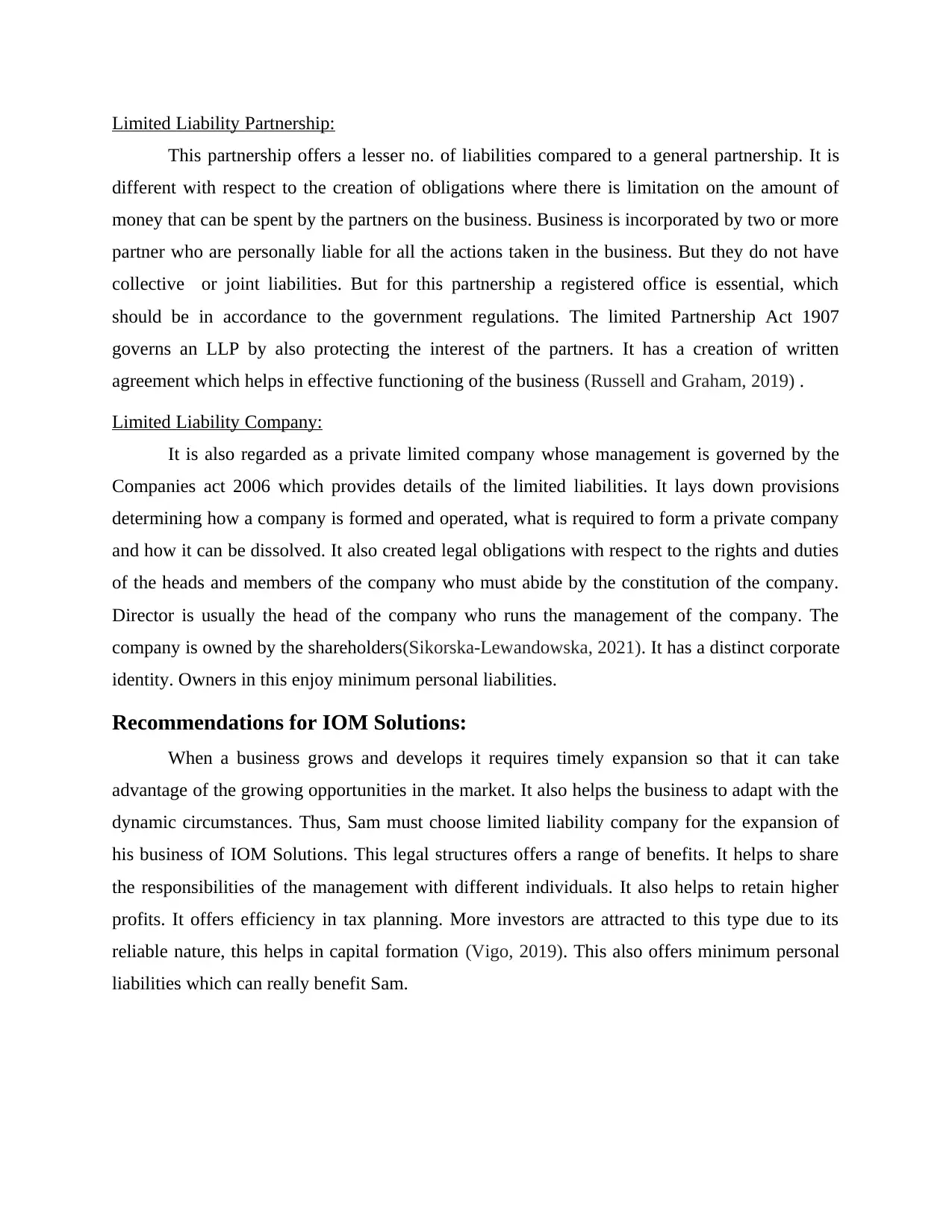
Limited Liability Partnership:
This partnership offers a lesser no. of liabilities compared to a general partnership. It is
different with respect to the creation of obligations where there is limitation on the amount of
money that can be spent by the partners on the business. Business is incorporated by two or more
partner who are personally liable for all the actions taken in the business. But they do not have
collective or joint liabilities. But for this partnership a registered office is essential, which
should be in accordance to the government regulations. The limited Partnership Act 1907
governs an LLP by also protecting the interest of the partners. It has a creation of written
agreement which helps in effective functioning of the business (Russell and Graham, 2019) .
Limited Liability Company:
It is also regarded as a private limited company whose management is governed by the
Companies act 2006 which provides details of the limited liabilities. It lays down provisions
determining how a company is formed and operated, what is required to form a private company
and how it can be dissolved. It also created legal obligations with respect to the rights and duties
of the heads and members of the company who must abide by the constitution of the company.
Director is usually the head of the company who runs the management of the company. The
company is owned by the shareholders(Sikorska-Lewandowska, 2021). It has a distinct corporate
identity. Owners in this enjoy minimum personal liabilities.
Recommendations for IOM Solutions:
When a business grows and develops it requires timely expansion so that it can take
advantage of the growing opportunities in the market. It also helps the business to adapt with the
dynamic circumstances. Thus, Sam must choose limited liability company for the expansion of
his business of IOM Solutions. This legal structures offers a range of benefits. It helps to share
the responsibilities of the management with different individuals. It also helps to retain higher
profits. It offers efficiency in tax planning. More investors are attracted to this type due to its
reliable nature, this helps in capital formation (Vigo, 2019). This also offers minimum personal
liabilities which can really benefit Sam.
This partnership offers a lesser no. of liabilities compared to a general partnership. It is
different with respect to the creation of obligations where there is limitation on the amount of
money that can be spent by the partners on the business. Business is incorporated by two or more
partner who are personally liable for all the actions taken in the business. But they do not have
collective or joint liabilities. But for this partnership a registered office is essential, which
should be in accordance to the government regulations. The limited Partnership Act 1907
governs an LLP by also protecting the interest of the partners. It has a creation of written
agreement which helps in effective functioning of the business (Russell and Graham, 2019) .
Limited Liability Company:
It is also regarded as a private limited company whose management is governed by the
Companies act 2006 which provides details of the limited liabilities. It lays down provisions
determining how a company is formed and operated, what is required to form a private company
and how it can be dissolved. It also created legal obligations with respect to the rights and duties
of the heads and members of the company who must abide by the constitution of the company.
Director is usually the head of the company who runs the management of the company. The
company is owned by the shareholders(Sikorska-Lewandowska, 2021). It has a distinct corporate
identity. Owners in this enjoy minimum personal liabilities.
Recommendations for IOM Solutions:
When a business grows and develops it requires timely expansion so that it can take
advantage of the growing opportunities in the market. It also helps the business to adapt with the
dynamic circumstances. Thus, Sam must choose limited liability company for the expansion of
his business of IOM Solutions. This legal structures offers a range of benefits. It helps to share
the responsibilities of the management with different individuals. It also helps to retain higher
profits. It offers efficiency in tax planning. More investors are attracted to this type due to its
reliable nature, this helps in capital formation (Vigo, 2019). This also offers minimum personal
liabilities which can really benefit Sam.
⊘ This is a preview!⊘
Do you want full access?
Subscribe today to unlock all pages.

Trusted by 1+ million students worldwide
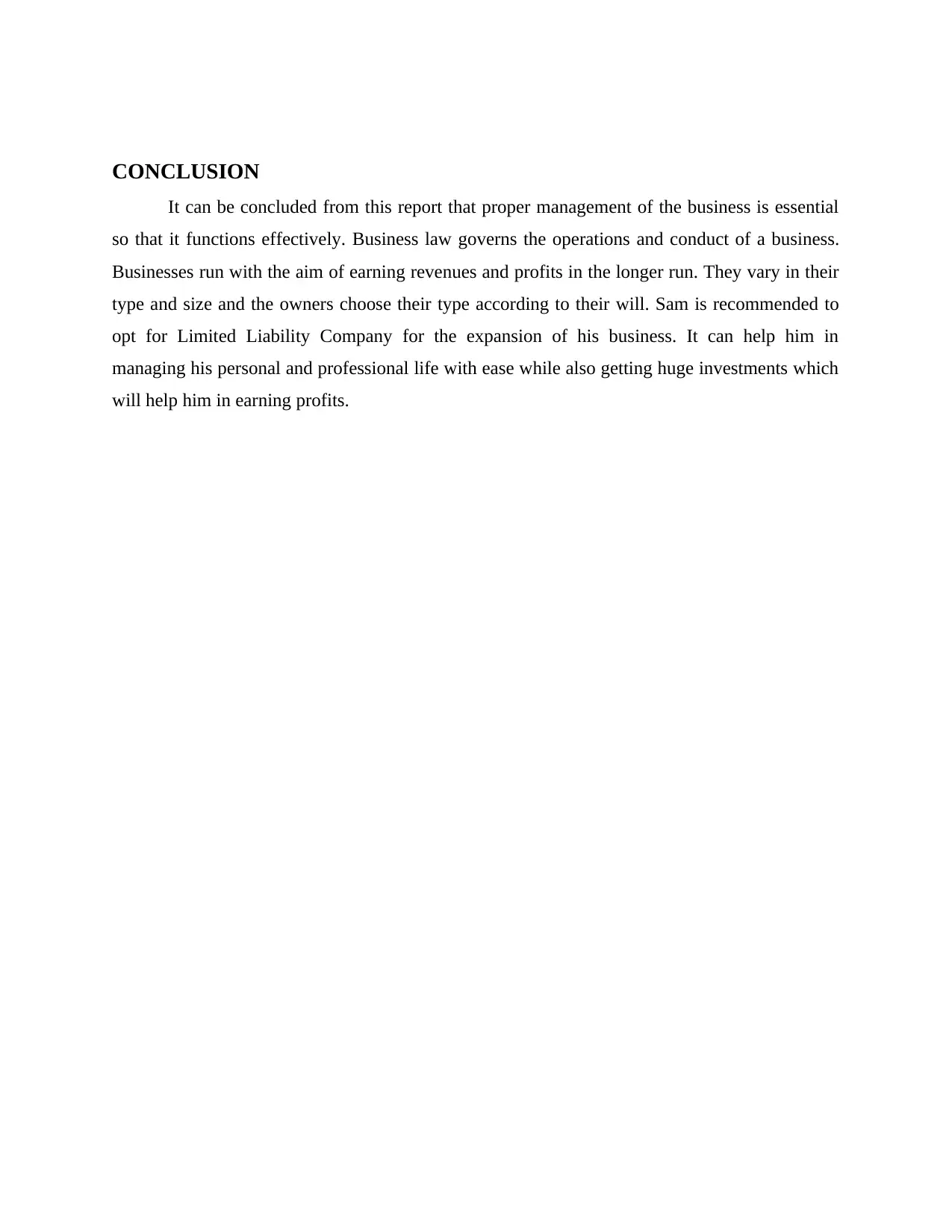
CONCLUSION
It can be concluded from this report that proper management of the business is essential
so that it functions effectively. Business law governs the operations and conduct of a business.
Businesses run with the aim of earning revenues and profits in the longer run. They vary in their
type and size and the owners choose their type according to their will. Sam is recommended to
opt for Limited Liability Company for the expansion of his business. It can help him in
managing his personal and professional life with ease while also getting huge investments which
will help him in earning profits.
It can be concluded from this report that proper management of the business is essential
so that it functions effectively. Business law governs the operations and conduct of a business.
Businesses run with the aim of earning revenues and profits in the longer run. They vary in their
type and size and the owners choose their type according to their will. Sam is recommended to
opt for Limited Liability Company for the expansion of his business. It can help him in
managing his personal and professional life with ease while also getting huge investments which
will help him in earning profits.
Paraphrase This Document
Need a fresh take? Get an instant paraphrase of this document with our AI Paraphraser
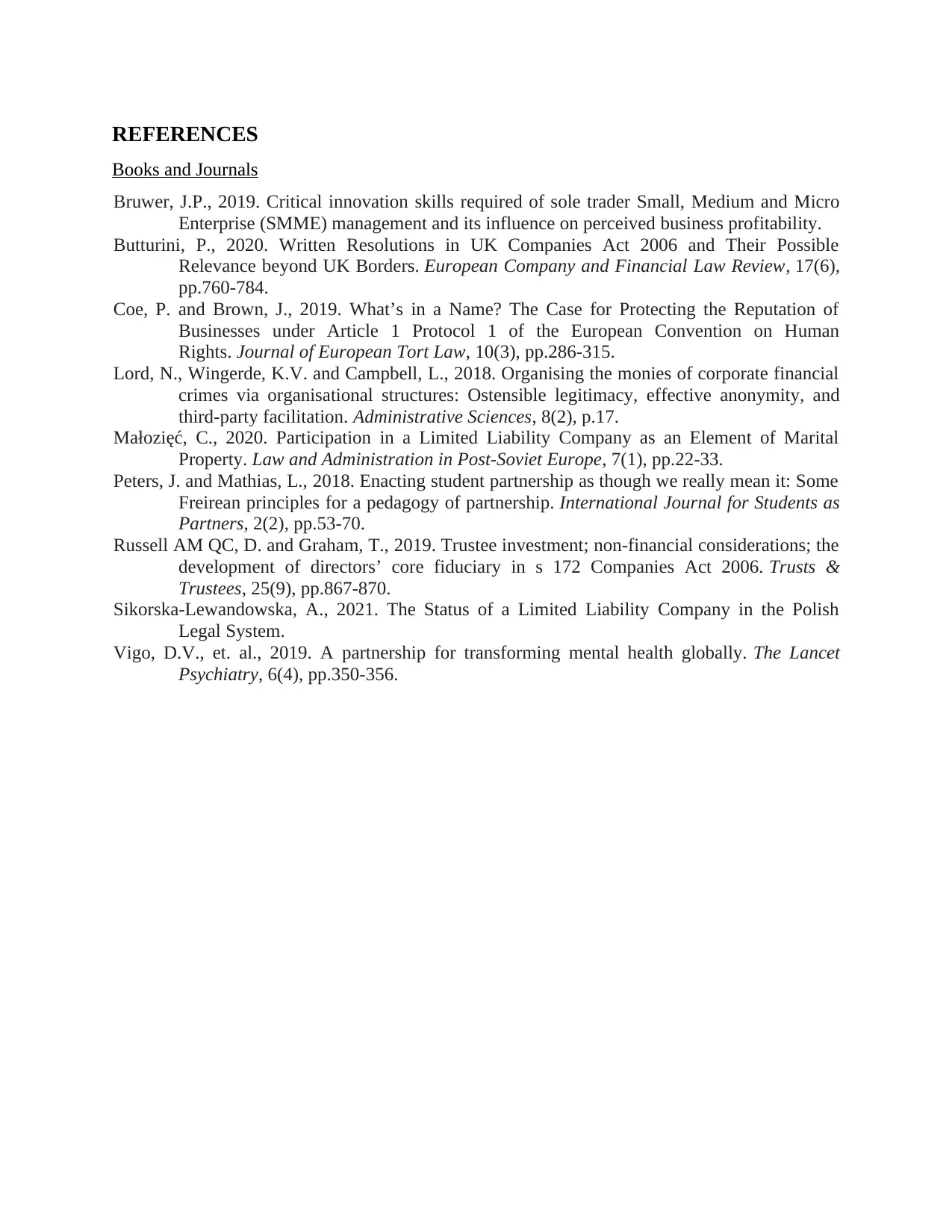
REFERENCES
Books and Journals
Bruwer, J.P., 2019. Critical innovation skills required of sole trader Small, Medium and Micro
Enterprise (SMME) management and its influence on perceived business profitability.
Butturini, P., 2020. Written Resolutions in UK Companies Act 2006 and Their Possible
Relevance beyond UK Borders. European Company and Financial Law Review, 17(6),
pp.760-784.
Coe, P. and Brown, J., 2019. What’s in a Name? The Case for Protecting the Reputation of
Businesses under Article 1 Protocol 1 of the European Convention on Human
Rights. Journal of European Tort Law, 10(3), pp.286-315.
Lord, N., Wingerde, K.V. and Campbell, L., 2018. Organising the monies of corporate financial
crimes via organisational structures: Ostensible legitimacy, effective anonymity, and
third-party facilitation. Administrative Sciences, 8(2), p.17.
Małozięć, C., 2020. Participation in a Limited Liability Company as an Element of Marital
Property. Law and Administration in Post-Soviet Europe, 7(1), pp.22-33.
Peters, J. and Mathias, L., 2018. Enacting student partnership as though we really mean it: Some
Freirean principles for a pedagogy of partnership. International Journal for Students as
Partners, 2(2), pp.53-70.
Russell AM QC, D. and Graham, T., 2019. Trustee investment; non-financial considerations; the
development of directors’ core fiduciary in s 172 Companies Act 2006. Trusts &
Trustees, 25(9), pp.867-870.
Sikorska-Lewandowska, A., 2021. The Status of a Limited Liability Company in the Polish
Legal System.
Vigo, D.V., et. al., 2019. A partnership for transforming mental health globally. The Lancet
Psychiatry, 6(4), pp.350-356.
Books and Journals
Bruwer, J.P., 2019. Critical innovation skills required of sole trader Small, Medium and Micro
Enterprise (SMME) management and its influence on perceived business profitability.
Butturini, P., 2020. Written Resolutions in UK Companies Act 2006 and Their Possible
Relevance beyond UK Borders. European Company and Financial Law Review, 17(6),
pp.760-784.
Coe, P. and Brown, J., 2019. What’s in a Name? The Case for Protecting the Reputation of
Businesses under Article 1 Protocol 1 of the European Convention on Human
Rights. Journal of European Tort Law, 10(3), pp.286-315.
Lord, N., Wingerde, K.V. and Campbell, L., 2018. Organising the monies of corporate financial
crimes via organisational structures: Ostensible legitimacy, effective anonymity, and
third-party facilitation. Administrative Sciences, 8(2), p.17.
Małozięć, C., 2020. Participation in a Limited Liability Company as an Element of Marital
Property. Law and Administration in Post-Soviet Europe, 7(1), pp.22-33.
Peters, J. and Mathias, L., 2018. Enacting student partnership as though we really mean it: Some
Freirean principles for a pedagogy of partnership. International Journal for Students as
Partners, 2(2), pp.53-70.
Russell AM QC, D. and Graham, T., 2019. Trustee investment; non-financial considerations; the
development of directors’ core fiduciary in s 172 Companies Act 2006. Trusts &
Trustees, 25(9), pp.867-870.
Sikorska-Lewandowska, A., 2021. The Status of a Limited Liability Company in the Polish
Legal System.
Vigo, D.V., et. al., 2019. A partnership for transforming mental health globally. The Lancet
Psychiatry, 6(4), pp.350-356.
1 out of 8
Related Documents
Your All-in-One AI-Powered Toolkit for Academic Success.
+13062052269
info@desklib.com
Available 24*7 on WhatsApp / Email
![[object Object]](/_next/static/media/star-bottom.7253800d.svg)
Unlock your academic potential
Copyright © 2020–2025 A2Z Services. All Rights Reserved. Developed and managed by ZUCOL.

